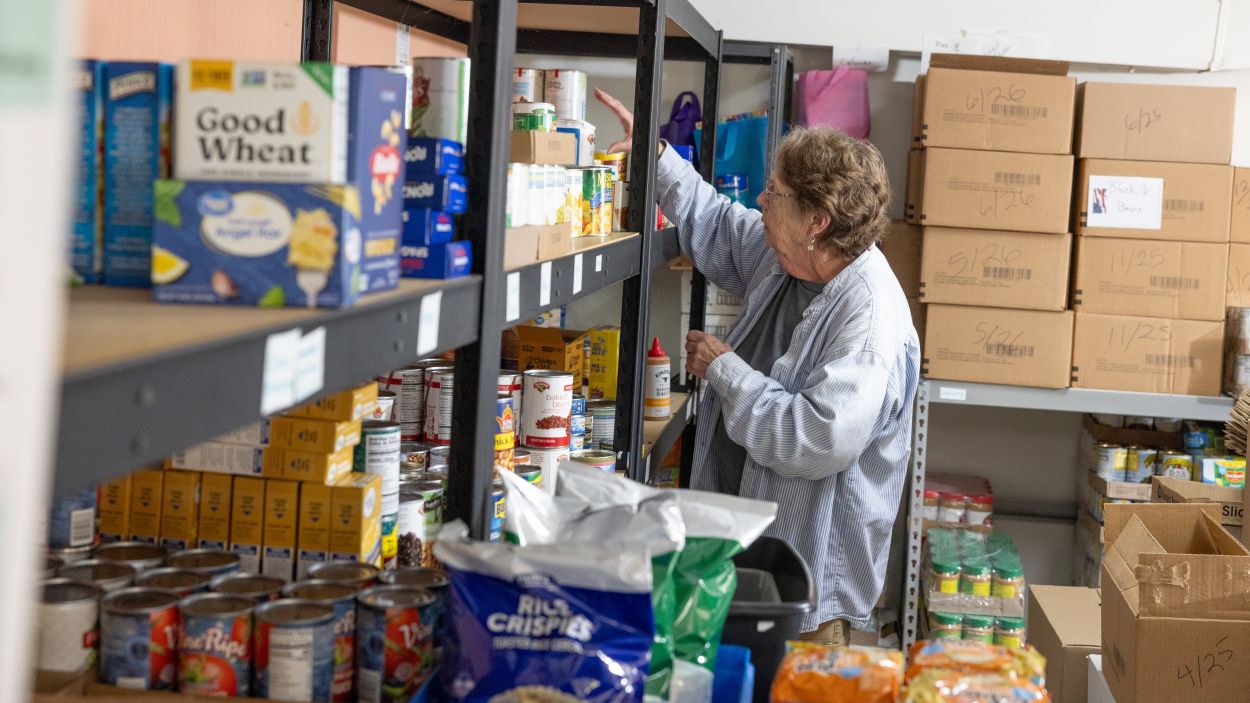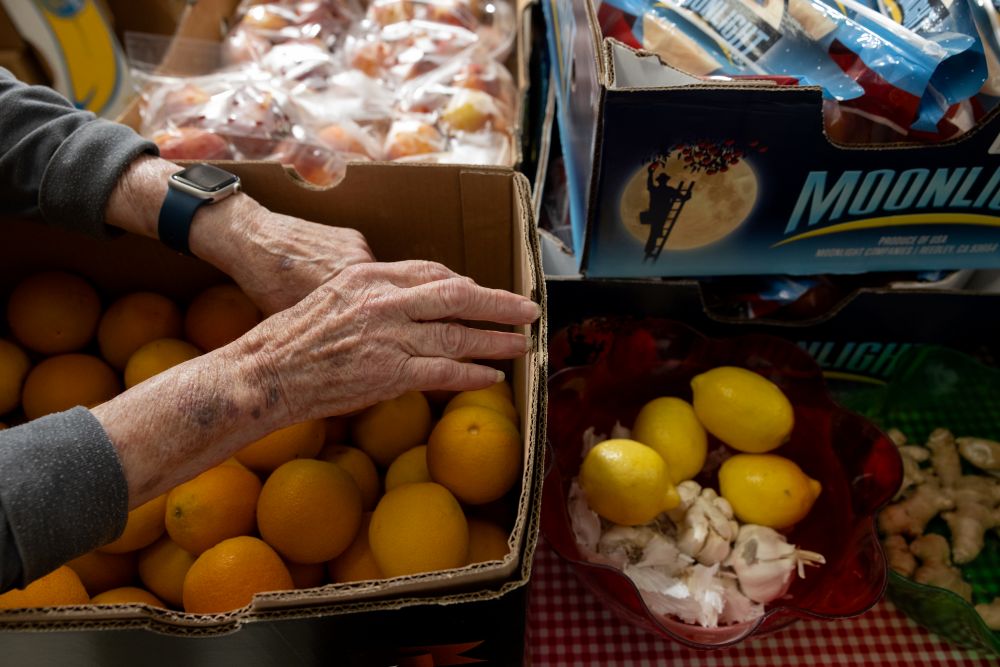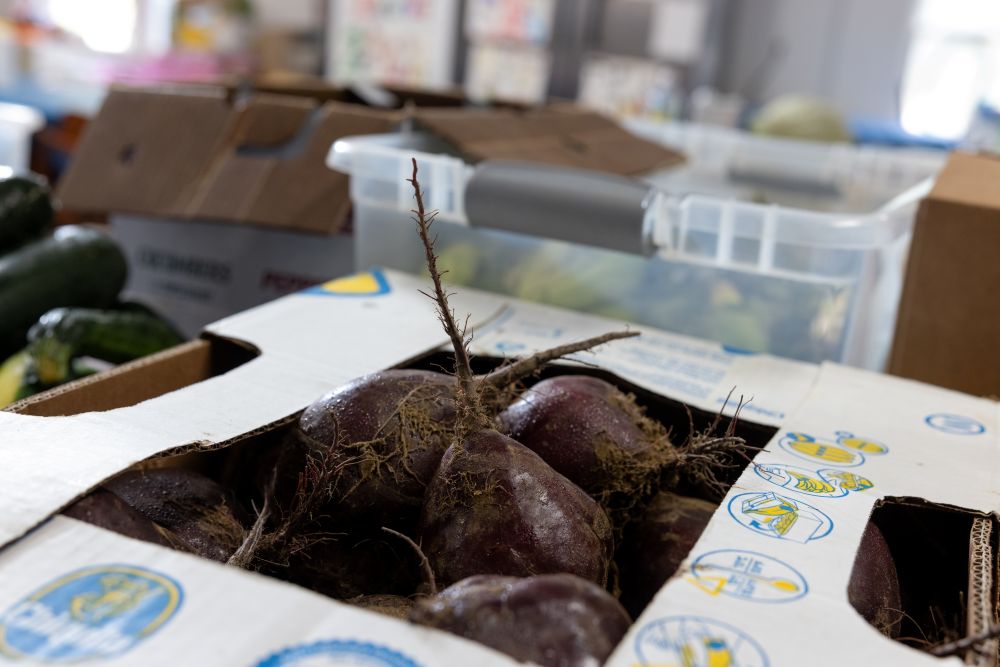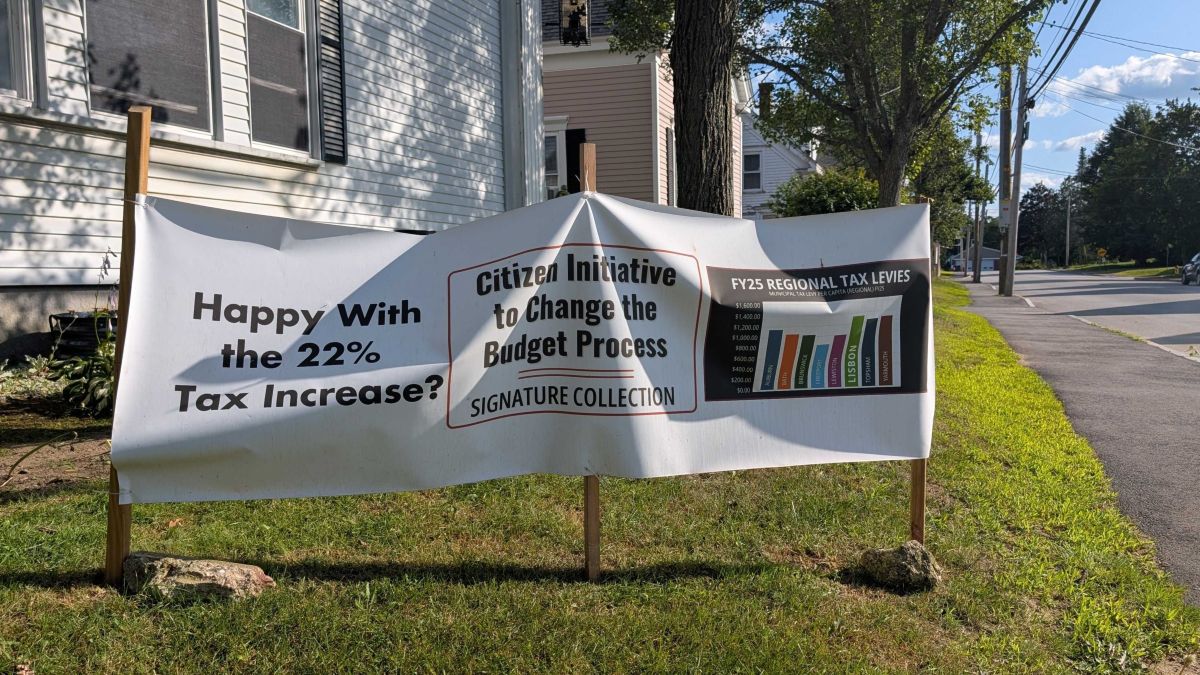Overlooked during the opioid crisis, more of Maine’s oldest began to struggle with drugs

Megan Harrigan hurried around the Union Street Brick Church in Bangor in September, gathering clients and bringing them to the back corner of the church where there was a makeshift clinic of folding tables and metal chairs. Each client was homeless, and most had an opioid addiction. Harrigan knew them all by name.
Between helping patients get referrals for opioid treatment medication, providing care for wounds that can come with opioid use, checking on clients she hadn’t seen in a while, and joking with other staff of the street medicine team, Harrigan talked with a Maine Monitor reporter about a shift she has witnessed in recent years: more older adults are doing harder drugs.
Harrigan, a mental health and rehabilitation technician, first started helping people with addiction more than 20 years ago. At that time, her older patients primarily struggled with prescription opioids. But regulatory crackdowns on overprescribing meant some of those patients turned to illicit drugs, now largely fentanyl, Harrigan said.
What’s more, she’s now working with more older people, a surprising observation as illicit drug use typically declines after young adulthood.
The opioid epidemic is still primarily a problem among younger people. But as it has worn on, a change has been happening that’s largely gone unnoticed. The Maine Monitor analyzed Medicare claims data to show for the first time that the number of Medicare patients in Maine, ages 65 and older, who received buprenorphine treatment for their addiction to opioids increased about 70 percent between 2019 and 2023.
This increase is large, but it represents a small number of all patients: about 450 more people seeking help at different health care systems and doctors across the state. It means the change might be imperceptible to individual medical practitioners. But some are starting to notice the increase in their every day, and it is worrying to them. They wonder if it is the start of a trend.
“Eventually they’re going to age, and our drugs are not stopping,” said Harrigan, a liaison with OPTIONS, a state-coordinated initiative that stands for Overdose Prevention Through Intensive Outreach Naloxone and Safety.
In Maine, some family doctors, addiction treatment providers and public health officials have seen anecdotal increases in older adults struggling with opioid use, pointing to the potential emergence of a growing problem in pockets of the state.
However, other organizations, including MaineHealth Behavioral Health based in Westbrook and the Bangor Area Recovery Network in Brewer, said they have not seen a notable increase in the older patients they serve.
Meanwhile, total overdoses in the state continue to plummet, and older adults account for a relatively small portion of those overdoses. Mainers 65 and older made up 23 percent of the state population but just 12 percent of nonfatal overdoses last year and 13 percent so far this year, according to the most recent state data.
Those between ages 35 and 44, in comparison, made up 12 percent of the population and 26 percent of nonfatal overdoses last year. It means some experts are hesitant to focus on a segment of the population with less need.
Gordon Smith, the state director of opioid response, said each age group deserves attention, but he has limited resources and a responsibility to focus on the most vulnerable groups. He added that opioid use disorder is an “adolescent onset disease,” and the vast majority of people who struggle with substance use started before they were 18, which is why prevention efforts focus on younger age groups.
“I have to be responsible for all my age cohorts, and where is the biggest struggle? Where is the biggest bang for my buck?” Smith said. “A lot of people want to — and this is not wrong — to put more into the adolescent population and deal with prevention because you have more years of life lost.”
As Maine’s population continues to age, others said the state should start planning for how to address what might become a growing problem.
Kaylie Smith, a licensed clinical professional counselor in the addiction care program at Northern Light Acadia Hospital in Bangor, works as a therapist for older adults receiving methadone or buprenorphine for an opioid addiction. While adults 65 and older make up only about 3 percent of her roughly 400 patients, she said that number has doubled during her decade working there. She thinks the trend will continue.
“It’s almost a special niche group, but I think it’s important to talk about because our population is aging,” Kaylie Smith said. “Maine is one of the oldest states in the nation, and that is impacting how patients are presenting with us.”
‘It’s all fentanyl’
Walt Bresnahan, now 68, first started taking opioids in his 30s after an old injury from playing sports started flaring up. He got a prescription for Percocet and became addicted, he said.
Bresnahan, of Old Orchard Beach, is now sober two years and seven months. He spends his time volunteering at the Portland Recovery Community Center. He hasn’t seen an increase in older adults attending the community center, but he said older people can be particularly hard to reach.
“The older generation right now is the Boomers,” he said. “What is the one thing that comes with those generations that sticks out more than anything? It’s pride.”
It can be harder for older Mainers to disclose they have a problem in part because they may feel more stigma than younger generations, according to those who help people with addiction.
Leon Licata, pastor at the Union Street Brick Church in Bangor, said he’s been stunned to see older people he serves getting involved in street drugs. People over 65 make up a small portion of those using the church’s warming and cooling center — he guessed maybe 5 percent — but anecdotally he has seen their numbers increase significantly in the last couple years.
A woman in her 70s at the shelter who spoke to a reporter insisted she had not used drugs in 30 years. Licata, who knows her, said that wasn’t true, but “they’re not going to tell you.”

Older adults with opioid use disorders may not look like the stereotype, said Dr. Rachel Solotaroff, clinical advisor for substance use disorder services at Penobscot Community Health Care based in Bangor. Most of her older patients smoke, rather than inject, and it’s more often women — usually “very frail women,” she said. She added that her observations are limited to those who are seeking help.
“It’s all fentanyl,” Solotaroff said, referring to the powerful synthetic opioid. “I haven’t seen heroin in a long time, nor prescription opioids.”
Often her patients started with prescription opioids, but then their use evolved to more illicit substances, Solotaroff said. And sometimes they’ve had long periods of sobriety in between, until they face a crisis such as losing their home.
Maine has made a significant effort to improve access to life-saving medications for opioid use disorder and harm reduction services such as safe syringe exchanges, Solotaroff said. But she believes the state needs to take more of a population-health approach to helping older adults, which would entail creating interventions designed specifically for this group.
“You also need an intentional focus by policymakers, by people who design these systems, on this population as distinct from a group of folks in their 40s or a group of folks in their 20s,” Solotaroff said.
Gordon Smith said his office looks at demographic data about overdoses every week. He pointed to initiatives such as youth recovery coaches as evidence of age-targeted programs.
“We have all kinds of strategies that look at particular populations, and we’re talking every day about whether it’s middle-aged people or older people,” he said. “It doesn’t matter whether you are 13 or 83, we’re going to have as many options available to people as possible.”
‘Maine is no exception’
Multiple health officials said older Mainers are likely to feel most comfortable talking to their primary care doctors. Solotaroff and two primary care doctors told The Monitor they are seeing increases in older patients struggling with opioid use disorder, although most hadn’t tracked it with data.
The nation as a whole is seeing a marked increase of older adults with an addiction to opioids. A recent study found a 9,000 percent increase in overdose deaths of older adults from fentanyl mixed with stimulants, such as cocaine and methamphetamines, over the past eight years.
Between 2014 and 2023, the number of overdose deaths from any opioid among people 55 and older increased threefold nationally and fivefold in Maine, according to a KFF analysis. Nationally, adults 65 and up experienced the largest increase in drug overdose rates of any age group from 2022 to 2023.
“I think the trend is clearly an issue, and Maine is no exception,” said Dr. Noah Nesin, a family care doctor and medical director of research and innovation at Community Care Partnership of Maine.
Nesin estimated that “overwhelmingly” people over 65 with opioid use disorder largely still use prescription opioids, but some people on the younger end might also have started using illicit opioids.
“It used to be earlier in my career that you would never see somebody in rural Maine, which is where I practiced, who had an opioid use disorder to anything other than prescription,” Nesin said. “Now we do see in , and in others where opioid use disorders are treated, people over 65 who have used illicit drugs like heroin and fentanyl.”

While Mainers 65-plus make up a small percentage of overdoses in the state, Nesin said he’d expect most of those overdoses to be fentanyl, not prescription opioids. It should raise alarms, he said. (The state does not publicize data showing the number of overdoses by age in each county.)
“We have to be alert to the possibility that a population of people for whom we previously didn’t have to consider illicit drug use as part of their addiction, that has to be considered and explicitly evaluated,” he said.
Doctors are prescribing far fewer opioids now, while prescriptions for buprenorphine, which treats opioid use disorder, have jumped. It was the top prescribed controlled medication in Maine last year, according to the state’s Prescription Monitoring Program.
While more people are seeking help, they may not always find it valuable. Nationally, fewer than 40 percent of Medicare beneficiaries with opioid use disorder received treatment that met quality metrics, according to a recent study published in Health Affairs.
Recognizing and treating opioid use among older adults comes with a unique set of challenges, said Dr. Erik Steele, a family physician at Martin’s Point primary care in Brunswick, who has been a doctor for 30 years. Opioid use can have cognitive effects that mimic aging issues, such as memory loss, ability to function and fall risks. An older patient may have more health conditions and prescribed medications that interact with opioids in different ways, and they may have chronic pain with few non-opioid treatment alternatives, he said.
Primary care doctors sometimes struggle to start conversations with older patients about opioid use because they don’t want to offend people in their care. When he does random drug testing and pill counts on older patients who have been on opioids for more than a decade, Steele said they often are surprised and insulted. He said he suspected family physicians might be less likely to do random drug screens on a 75-year-old who has been on opioids for 10 years than a 40-year-old who has been on them for five years.
“There’s no question that asking somebody, in common parlance, ‘Are you addicted to your medication?’ is a challenging conversation and is potentially a barrier to asking it,” Steele said. “As you do more and more of this work, you do get more comfortable asking the question.”
With older patients, Steele said, it’s especially important to figure out if they are physiologically dependent on the opioids, meaning they would experience withdrawal symptoms, or if they are pathologically dependent, meaning they are using opioids to treat an underlying issue such as post-traumatic stress, anxiety or depression — in an escalating manner to the point where it becomes an illness. There isn’t good data currently about how many older patients are pathologically addicted to opioids, he said.
‘It reflects broader shifts’
A growing number of Medicare recipients in Maine are getting buprenorphine to medically treat opioid use disorder.
Between 2019 and 2023, the number of Medicare recipients in Maine receiving buprenorphine, who were 65 and older, increased from 638 to 1,087, according to a Maine Monitor analysis of Medicare claims data. That’s a 70 percent increase, while the overall population of Mainers 65 and older grew 12 percent during that time.
The numbers are likely an undercount because The Monitor did not include totals for categories of buprenorphine that were suppressed because they were too small for Medicare to publish. The numbers also do not include how many people took other drugs, such as naltrexone and methadone, to treat opioid use disorder.
Christy Daggett, CEO of Aroostook Mental Health Services, said any increase in older adults seeking treatment is a hopeful sign that they feel more comfortable reaching out for help. The facility’s total number of Aroostook County patients in treatment for opioid use decreased 12 percent between fiscal years in 2020 and 2025, but clients who were 65 and older increased slightly from 14 to 21.
Even as more older adults are seeking treatment, it can be difficult for them to continue taking opioid treatment medications when they need higher levels of care for other health problems. Multiple providers told The Monitor that nursing homes and assisted living facilities are not equipped to handle people with opioid addictions.

Kaylie Smith, from Northern Light Acadia Hospital, said treatment should be more available in all health care settings. Sometimes her patients have a hard time going to rehabilitation facilities because they can’t get their methadone, which is often dispensed at regulated clinics.
“For them to go without their medicine, it’s just not realistic because that would totally destabilize them in different ways,” Smith said. “It’s like you’re choosing which way you want to be destabilized.”
In 2022, Amelia Hersey tried to change that. As a physician’s assistant specializing in geriatric substance use, she spent a year working with a dozen nursing homes across the state to establish and expand their policies to better serve residents with addiction.
“We made very little gains, unfortunately,” she said, and “met a lot of resistance.”
The only nursing homes that ultimately updated their practices were the two where she was already employed. There was near constant turnover in nursing homes, forcing her to retrain new people and get buy-in from new administrators, she said. In addition, staff are overworked with limited capacity for more tasks.
The Maine Health Care Association, which represents nursing homes and assisted living facilities, said these facilities are already caring for more residents with substance use disorders.
“This isn’t uncommon anymore,” said Angela Cole Westhoff, president and CEO of the industry group. “It reflects broader shifts in both the population and the challenges people are living with as they age.”
Maine Monitor reporter Taylor Nichols contributed data reporting to this story.
This story was made possible in part by a workshop on reporting on aging, convened by the Craig Newmark Graduate School of Journalism at CUNY.


















